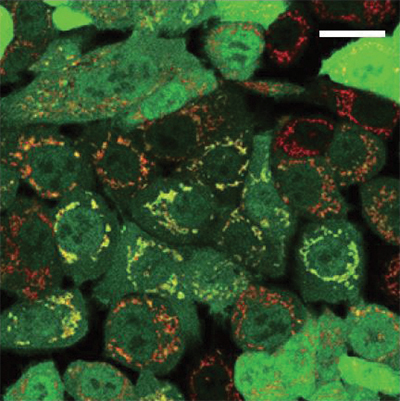JBC: Researchers link new protein to ParkinsonŌĆÖs
Researchers in Japan are reporting new insight into how the Parkinson’s disease-associated protein parkin selects its targets. The finding might improve experimental therapies for Parkinson’s that aim to boost parkin activity.

Cells depend on parkin to help get rid of damaged mitochondria. , published in the Journal of Biological Chemistry, suggests that parkin depends on other proteins, including one called MITOL that has not been linked previously to Parkinson’s disease, to direct it to those damaged mitochondria.
Parkin adds a degradation tag called ubiquitin to proteins on the mitochondrial surface. In some patients with familial Parkinson’s disease, parkin activity is disrupted and bad mitochondria cannot be destroyed. Harmful byproducts from those bad mitochondria can damage neurons. By understanding how parkin works and what goes wrong when it’s mutated, researchers hope also to help patients with other forms of Parkinson’s disease.
While other ubiquitin-tagging proteins, known as E3 ligases, recognize specific amino acid sequences on their substrates, parkin has many known substrates that don’t seem to share a sequence in common. While studying how parkin chooses its substrates, researchers led by Fumika Koyano in at the Tokyo Metropolitan Institute of Medical Science discovered that parkin can tag any lysine-containing protein with ubiquitin — even a bacterial protein not ordinarily found in the cell — as long as it’s present at the surface of the mitochondria.
“Parkin is not regulated by its substrate specificity,” Koyano said of the finding. Instead, control of parkin activity comes from how it is recruited and activated by other proteins.
The discovery that activated parkin is not terribly selective led Koyano and her colleagues to take a closer look at parkin’s recruitment and activation. Some details of that process are well known; for example, a protein called PINK1 is known to boost parkin activity. But Koyano and colleagues discovered a new step that must happen before PINK1 can contribute to parkin activation. They found that parkin acts more rapidly when a first ubiquitin molecule is already present, acting as a seed for the addition of more ubiquitins. In most cases, the researchers found, this seed ubiquitin is added by a protein called MITOL, which had not been linked previously to Parkinson’s.
The research could contribute to the design of new drugs, some of which aim to boost parkin activity to slow the advance of Parkinson’s disease.
“If we achieve upregulation of seed ubiquitylation on mitochondria,” Koyano said, “it might accelerate parkin recruitment and parkin activation to eliminate damaged mitochondria more efficiently.”
Enjoy reading ASBMB Today?
Become a member to receive the print edition four times a year and the digital edition monthly.
Learn moreGet the latest from ASBMB Today
Enter your email address, and weŌĆÖll send you a weekly email with recent articles, interviews and more.
Latest in Science
Science highlights or most popular articles

Bacterial enzyme catalyzes body odor compound formation
Researchers identify a skin-resident Staphylococcus hominis dipeptidase involved in creating sulfur-containing secretions. Read more about this recent Journal of Biological Chemistry paper.

Neurobiology of stress and substance use
MOSAIC scholar and proud Latino, Bryan Cruz of Scripps Research Institute studies the neurochemical origins of PTSD-related alcohol use using a multidisciplinary approach.

Pesticide disrupts neuronal potentiation
New research reveals how deltamethrin may disrupt brain development by altering the protein cargo of brain-derived extracellular vesicles. Read more about this recent Molecular & Cellular Proteomics article.

A look into the rice glycoproteome
Researchers mapped posttranslational modifications in Oryza sativa, revealing hundreds of alterations tied to key plant processes. Read more about this recent Molecular & Cellular Proteomics paper.

Proteomic variation in heart tissues
By tracking protein changes in stem cellŌĆōderived heart cells, researchers from Cedars-Sinai uncovered surprising diversity ŌĆö including a potential new cell type ŌĆö that could reshape how we study and treat heart disease.

Parsing plant pigment pathways
Erich Grotewold of Michigan State University, an ASBMB Breakthroughs speaker, discusses his work on the genetic regulation of flavonoid biosynthesis.

